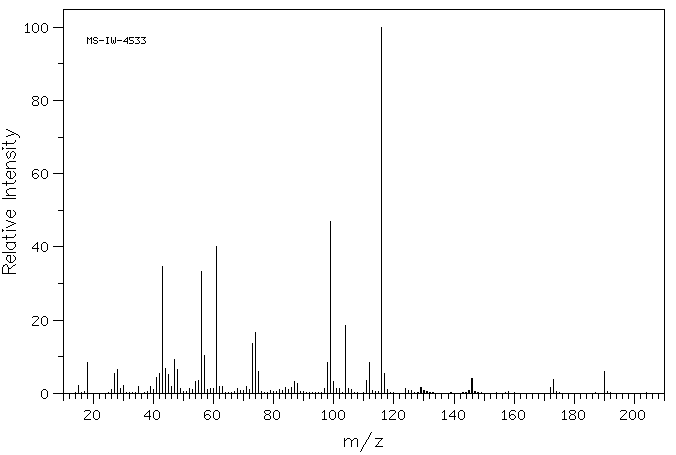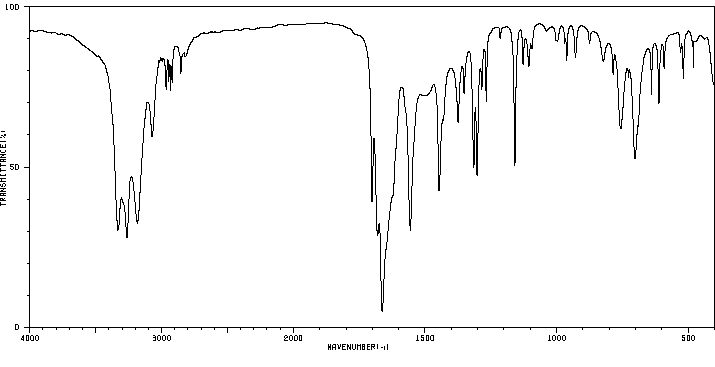N-acetyl methionine amide | 60325-30-6
中文名称
——
中文别名
——
英文名称
N-acetyl methionine amide
英文别名
N-Ac-DL-Met-NH2;N-acetyl-methionine amide;N-Acetyl-methionin-amid;N-Acetyl-DL-methioninamide;2-acetamido-4-methylsulfanylbutanamide
CAS
60325-30-6
化学式
C7H14N2O2S
mdl
——
分子量
190.266
InChiKey
AJQATZBTQNYZFO-UHFFFAOYSA-N
BEILSTEIN
——
EINECS
——
-
物化性质
-
计算性质
-
ADMET
-
安全信息
-
SDS
-
制备方法与用途
-
上下游信息
-
文献信息
-
表征谱图
-
同类化合物
-
相关功能分类
-
相关结构分类
物化性质
-
沸点:477.4±40.0 °C(Predicted)
-
密度:1.151±0.06 g/cm3(Predicted)
计算性质
-
辛醇/水分配系数(LogP):-0.6
-
重原子数:12
-
可旋转键数:5
-
环数:0.0
-
sp3杂化的碳原子比例:0.71
-
拓扑面积:97.5
-
氢给体数:2
-
氢受体数:3
SDS
上下游信息
-
下游产品
中文名称 英文名称 CAS号 化学式 分子量 N-乙酰-L-蛋氨酸 AcMetH 65-82-7 C7H13NO3S 191.251
反应信息
-
作为反应物:描述:N-acetyl methionine amide 在 potassium phosphate buffer 作用下, 反应 1.0h, 生成 N-乙酰-L-蛋氨酸参考文献:名称:Nishida, Yutaka; Nabe, Koichi; Yamada, Shigeki, Agricultural and Biological Chemistry, 1983, vol. 47, # 7, p. 1667 - 1668摘要:DOI:
-
作为产物:描述:参考文献:名称:DE814445摘要:公开号:
文献信息
-
[EN] DRUG ANTIBODY CONJUGATES<br/>[FR] CONJUGUÉS MÉDICAMENT-ANTICORPS申请人:PHARMA MAR SA公开号:WO2021214126A1公开(公告)日:2021-10-28Drug conjugates having formula [D-(X)b-(AA)w-(T)g-(L)-]n-Ab wherein: D is a drug moiety having the following formula (I) or a pharmaceutically acceptable salt, ester, solvate, tautomer or stereoisomer thereof, (I) wherein D is covalently attached via a hydroxy or amine group to (X)b if any, or (AA)w if any, or to (T)g if any, or (L); that are useful in the treatment of cancer.
-
[EN] DRUG ANTIBODY CONJUGATES<br/>[FR] CONJUGUÉS ANTICORPS-MÉDICAMENTS申请人:PHARMA MAR SA公开号:WO2021043951A1公开(公告)日:2021-03-11Drug conjugates having formula [D-(X)b-(AA)w-(T)g-(L)-]n-Ab wherein: D is a drug moiety having the following formula (I) or a pharmaceutically acceptable salt or ester thereof, wherein D is covalently attached via a hydroxy group at OR1, OR3 or ZH, or a thiol group at ZH to (X)b if any, or (AA)w if any, or to (T)g if any, or (L); that are useful in the treatment of cancer.
-
[EN] SYNTHETIC PROCESS FOR THE MANUFACTURE OF ECTEINASCIDIN COMPOUNDS<br/>[FR] PROCÉDÉ DE SYNTHÈSE POUR LA PRÉPARATION DE COMPOSÉS ECTEINASCIDINES申请人:PHARMA MAR SA公开号:WO2011147828A1公开(公告)日:2011-12-01This invention relates to compounds of formula II: wherein R1, R2, ProtSH, and ProtNH are as defined, to processes for the synthesis of ectainascidins of formula I from compounds of formula II, and to processes for the synthesis of compounds of formula II.这项发明涉及到式子II的化合物:其中R1、R2、ProtSH和ProtNH的定义如下,以及从式子II的化合物合成式子I的ectainascidins的过程,以及合成式子II的化合物的过程。
-
A transition-metal chromophore as a new, sensitive spectroscopic tag for proteins. Selective covalent labeling of histidine residues in cytochromes c with chloro(2,2':6'2"-terpyridine)platinum(II) chloride作者:Eva Marie A. Ratilla、Herb M. Brothers、Nenad M. KosticDOI:10.1021/ja00249a023日期:1987.7opposite from that of PtCl/sub 4//sup 2 -/ although both of them are platinum(II)-chloro complexes. Owing to an interplay between the steric and electronic effects of the terpyridyl ligand, the new reagent is unreactive toward methionine (a thio ether) and cystine (a disulfide), which are otherwise highly nucleophilic ligands, but very reactive toward imidazole, which is otherwise a relativelymore » weak以马和金枪鱼的细胞色素 c 为例,研究了 Pt(trpy)Cl/sup +/ 对蛋白质的反应性和选择性。新的过渡金属试剂在 pH 5 时对组氨酸残基具有特异性。通过咪唑轻松一步置换 Cl/sup -/ 配体的反应产生了良好的产率。结合位点,马蛋白中的 His 26 和 His 33 以及金枪鱼蛋白中的 His 26,通过紫外-可见分光光度法和肽图实验确定。制备并表征了咪唑、组氨酸、组氨酸衍生物和含组氨酸肽的模型复合物。共价连接的 Pt(trpy)/sup 2 +/ 标记允许通过阳离子交换色谱轻松分离蛋白质衍生物。标签不会干扰细胞色素 c 的构象和还原潜力,如紫外可见分光光度法、循环伏安法、微分脉冲伏安法、EPR 光谱和 /sup 1/H NMR 光谱所示。Pt(trpy)Cl/sup +/ 的选择性与 PtCl/sub 4//sup 2 -/ 的选择性完全相反,尽管它们都是铂 (II)-氯
-
Steric effects on the selectivity of protein labelling with chelate complexes of platinum(II)作者:Xia Ying Zhou、Nenad M. KostićDOI:10.1016/s0277-5387(00)84010-3日期:1990.1The Cl− ligand in complexes of the type [Pt(tridentate)Cl] can be displaced by amino-acid side chains in proteins so that the Pt(tridentate) tag becomes covalently attached to the protein. The selectivity in this displacement can be controlled by adjusting the steric properties of the tridentate ligand. In the complex [Pt(dipic)Cl]−, in which dipic represents 2,6-pyridinedicarboxylate, the Cl− ligand[Pt(三齿)Cl]型复合物中的Cl-配体可以被蛋白质中的氨基酸侧链取代,从而Pt(三齿)标签与蛋白质共价连接。可以通过调节三齿配体的空间性质来控制该位移的选择性。在复合物[Pt(dipic)Cl]-中,二斜体表示2,6-吡啶二羧酸盐,Cl-配体是可及的。该复合物与蛋氨酸和组氨酸及其衍生物以及细胞色素c中蛋氨酸65的侧链反应。氨基酸侧链对[Pt(trpy)Cl]-的反应性主要取决于它们的亲核性。蛋氨酸中的软硫醚配体比组氨酸中的硬咪唑配体更具反应性。在配合物[Pt(dpes)Cl] +中,其中dpes代表二(2-吡啶基-β-乙基)硫化物,Cl-配体被部分屏蔽。该络合物与细胞色素c中的N-乙酰甲硫氨酸,N-乙酰组氨酸和甲硫氨酸65和组氨酸33的侧链反应。氨基酸侧链对[Pt(dpes)Cl] +的反应性取决于它们的空间体积以及亲核性。蛋氨酸中的硫醚配体比组氨酸中的咪唑配体反应性差。立体化学原理可
表征谱图
-
氢谱1HNMR
-
质谱MS
-
碳谱13CNMR
-
红外IR
-
拉曼Raman
-
峰位数据
-
峰位匹配
-
表征信息
同类化合物
(甲基3-(二甲基氨基)-2-苯基-2H-azirene-2-羧酸乙酯)
(±)-盐酸氯吡格雷
(±)-丙酰肉碱氯化物
(d(CH2)51,Tyr(Me)2,Arg8)-血管加压素
(S)-(+)-α-氨基-4-羧基-2-甲基苯乙酸
(S)-阿拉考特盐酸盐
(S)-赖诺普利-d5钠
(S)-2-氨基-5-氧代己酸,氢溴酸盐
(S)-2-[[[(1R,2R)-2-[[[3,5-双(叔丁基)-2-羟基苯基]亚甲基]氨基]环己基]硫脲基]-N-苄基-N,3,3-三甲基丁酰胺
(S)-2-[3-[(1R,2R)-2-(二丙基氨基)环己基]硫脲基]-N-异丙基-3,3-二甲基丁酰胺
(S)-1-(4-氨基氧基乙酰胺基苄基)乙二胺四乙酸
(S)-1-[N-[3-苯基-1-[(苯基甲氧基)羰基]丙基]-L-丙氨酰基]-L-脯氨酸
(R)-乙基N-甲酰基-N-(1-苯乙基)甘氨酸
(R)-丙酰肉碱-d3氯化物
(R)-4-N-Cbz-哌嗪-2-甲酸甲酯
(R)-3-氨基-2-苄基丙酸盐酸盐
(R)-1-(3-溴-2-甲基-1-氧丙基)-L-脯氨酸
(N-[(苄氧基)羰基]丙氨酰-N〜5〜-(diaminomethylidene)鸟氨酸)
(6-氯-2-吲哚基甲基)乙酰氨基丙二酸二乙酯
(4R)-N-亚硝基噻唑烷-4-羧酸
(3R)-1-噻-4-氮杂螺[4.4]壬烷-3-羧酸
(3-硝基-1H-1,2,4-三唑-1-基)乙酸乙酯
(2S,4R)-Boc-4-环己基-吡咯烷-2-羧酸
(2S,3S,5S)-2-氨基-3-羟基-1,6-二苯己烷-5-N-氨基甲酰基-L-缬氨酸
(2S,3S)-3-((S)-1-((1-(4-氟苯基)-1H-1,2,3-三唑-4-基)-甲基氨基)-1-氧-3-(噻唑-4-基)丙-2-基氨基甲酰基)-环氧乙烷-2-羧酸
(2S)-2,6-二氨基-N-[4-(5-氟-1,3-苯并噻唑-2-基)-2-甲基苯基]己酰胺二盐酸盐
(2S)-2-氨基-N,3,3-三甲基-N-(苯甲基)丁酰胺
(2S)-2-氨基-3-甲基-N-2-吡啶基丁酰胺
(2S)-2-氨基-3,3-二甲基-N-(苯基甲基)丁酰胺,
(2S)-2-氨基-3,3-二甲基-N-2-吡啶基丁酰胺
(2S,4R)-1-((S)-2-氨基-3,3-二甲基丁酰基)-4-羟基-N-(4-(4-甲基噻唑-5-基)苄基)吡咯烷-2-甲酰胺盐酸盐
(2R,3'S)苯那普利叔丁基酯d5
(2R)-2-氨基-3,3-二甲基-N-(苯甲基)丁酰胺
(2-氯丙烯基)草酰氯
(1S,3S,5S)-2-Boc-2-氮杂双环[3.1.0]己烷-3-羧酸
(1R,5R,6R)-5-(1-乙基丙氧基)-7-氧杂双环[4.1.0]庚-3-烯-3-羧酸乙基酯
(1R,4R,5S,6R)-4-氨基-2-氧杂双环[3.1.0]己烷-4,6-二羧酸
齐特巴坦
齐德巴坦钠盐
齐墩果-12-烯-28-酸,2,3-二羟基-,苯基甲基酯,(2a,3a)-
齐墩果-12-烯-28-酸,2,3-二羟基-,羧基甲基酯,(2a,3b)-(9CI)
黄酮-8-乙酸二甲氨基乙基酯
黄荧菌素
黄体生成激素释放激素(1-6)
黄体生成激素释放激素 (1-5) 酰肼
黄体瑞林
麦醇溶蛋白
麦角硫因
麦芽聚糖六乙酸酯
麦根酸








